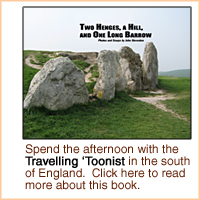
In America, England, Australia.... just about anywhere, you can find history. Prehistoric peoples wandered the land and cluttered it up with burial mounds, henges, rock carvings, standing stones... you name it. All kinds of stuff that was so very important to them. Then Historic Man came along and decided everything would look nice plowed over and plundered. Then Modern Man came along and decided he could profit by building as many shopping and eating establishments as possible, and making sure there was plenty of parking to go along with it.
In the Uk recently an ancient long house was excavated quickly so a car park could go in on schedule. Here in Ohio archeologists had to move fast to save some very important artifacts so that a new runway could go in at the airport. Even at Stonehenge, that most famous of monuments, there is a sign at the car park saying that some 3000 year old giant carved trees had once stood on that spot, somewhere under the tarmac!
Obviously, these ancient sites meant a lot to their builders. Obviously, modern man needs places to sleep, shop, and eat pizza. So where do we draw the line? In a recent post here I was moaning about the loss of so much Native American prehistory here in Ohio. "Why oh why did they have to destroy so much?!" I cried! Then I looked at "Prehistoric Earthworks in Ohio by William C. Mills, from the 1914 Archeological Atlas of Ohio. There were thousands of earthworks, including burial mounds, ceremonial temple mounds, fortifications, village enclosures.. and then there were petroglyph sites, stone piles, and others. That's a lot of red dots on the map! See this link if you don't believe me: http://www.gustavslibrary.com/mounddistributionmap.jpg
So where Do we draw the line between preserving the past and making way for 'progress'? A compromise would be nice, such as living alongside the monuments from the past, but in many cases it's much too late for that. The decision should have been made years ago.
In all fairness, most people simply do not care about the past... just a bunch of rocks and dirt, some people say. So let's have a dialog here.
"The Native Americans moved into Ohio perhaps 15,000 years ago!"
"Yeah, but we is here now."
"Only because 'we' forced them from their homes!"
"Might makes right, loser!"
Never mind... this kind of conversation inevitably leads to disaster, since both sides have very different points of view. The truth is.. in most cases it is too late. Here in Ohio I've been told that everything was plowed over, so that even the monuments we see today are not truly their original selves. I've been here two weeks now, and in two different walks have seen evidence of artifacts that were ground into pieces.. broken pottery, a broken adze, a piece of clay pipe... the last two were not far from a certain burial mound I featured here, so even that was 'spoiled'.
Even in our attempts to preserve the past, I believe we are failing. Some believe that letting the land go fallow is allowing the sites to be seen in their 'natural' state. Well, just what IS their natural state? We are not sure of the purpose of many of these sites, so how do we know what they should look like? The Native Americans did not have lawn mowers, unless you count sheep, but letting grass grow on earthworks is a better method of preserving them than letting them grow fallow.

Case in point, the Jeffers Mound as seen in the photo above. The Jeffers Mound is all that is left of a vast complex that included huge earthworks, a burial mound, a ceremonial mound (the Jeffers Mound), two circular enclosures, and longhouses. Who knows what else? The land was farmed for years until it was subdivided and sold into housing lots. Mr. Jeffers thankfully did not sell the land the Jeffers Mound was on, so this is all that remains of this once great complex.

Now look at the photo above... can you even see the mound? It's like 25 feet high, but I had some people with me on the visit and they all saw a 'bunch of bushes' until I pointed out to them that it wa a mound. What bothers me though is the trees. If left in the woods, nature would eventually destroy these mounds on it's own,(see first photo above of Cole Earthworks) but this mound is supposedly being preserved, and there are 40 foot high trees growing out of it! That means there are 40 feet of roots burrowing through the mound, and when those tipping trees fall, there goes the mound.
Oh well... let's just help nature along, shall we? This site is just wasted space, innit? Let's put up a bus shelter with matching car park and put this space to use, eh?
Just remember one thing, though. These ancient peoples lived a long time ago, so we say 'their time has passed', and plow over the graves of their ancestors. Well, how would you feel if those were YOUR ancestors being plowed over? It could happen, you know. And not just in the movies. Case in point, the Pool family. They plowed over the two mounds I mentioned in my earlier blog, and lived here for some time in the 1800's. Not too long ago, right? And their gravestones were found 'somewhere south of Highbanks Metro Park, and no one is sure where their bodies are. Their stones now sit together in a little fenced off area... a 'pretend' burial plot.

And progress and history march on... :0)
Cheers, JOHN :0)









